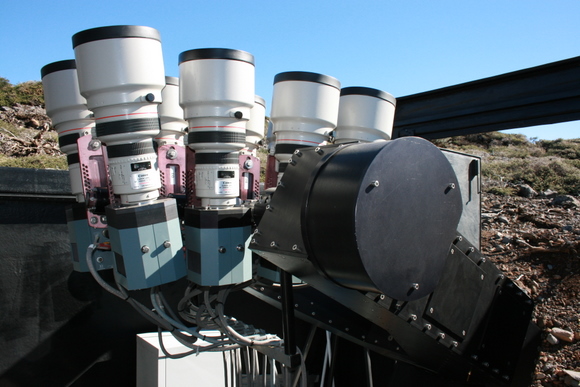[/caption]
Originally discovered by the Wide Angle Search for exoPlanets (WASP) survey in 2008, the eclipsing exoplanet WASP 10b has been reluctant to allow its properties to be pinned down. While its mass has been pinned down by two independent groups to right around 3 times the mass of Jupiter, the radius and thus, the overall density which gives hints at the composition, has been harder to determine. Groups have also reported oddities in the timing of the eclipses that may hint at the presence of another planets whose gravitational tug is changing the orbit of 10b. A new study attempts to answer these questions with high precision observations from the Spanish 2.2 meter Calar Alto Observatory.
The new study, led by astronomers from Nicolaus Copernicus University in Poland, is the first of WASP 10b to take into account the effects of star spots. Since the host star is a K-dwarf such spots should be common. When such spots are present, the planet can eclipse them as well, making the overall brightness increase temporarily. This apparent change in the brightness of the star makes small changes in how astronomers would determine the overall brightness of the star. This brightness is used to determine the properties of the star, such as its radius, which also factor into determining the radius of the planet. As such, these spots should be taken into account for the most accurate understanding possible.
The team observed four transits of the planet in late 2010. In that time, star spots were present for three of the four transits. With the spots subtracted out, the team agreed with previous estimates of mass, but found an even lower value for the radius than either of the previous studies. Their value was only a few percent wider than Jupiter despite being three times as massive. While this doesn’t make WASP 10b most dense planet known, it does rank among the top contenders.
These results have implications for how planets may form in general. Since WASP 10 is estimated to be a relatively young star, it would imply that the major planet formed a rocky core early on and that it wasn’t deposited later through collisions. The team estimates that it would require a total mass for the core of roughly 300-400 times the mass of Earth.
When the team added their new data to previous studies of the system, they found that the timing of the transits have continued to change and these changes could not be the product of other effects, such as star spots on the limb of the star altering the shape of the light curve. As such, they note that “this finding supports a scenario in which the second planet perturbs the orbital motion of WASP 10b.”


Can Kepler be pointed at it or would that be considered academic poaching by the WASP team?
well kepler looks at the same portion of sky for a reason – so that we can find planets with long-period orbits that eclipse their parent star just once every few hundreds of days, or even few years. it would be such a waste to point him in different direction now!
Kepler doesn’t really find planets in a precise way – it finds candidates and then other telescopes have to confirm whether there are actually any planets around the star in question. It would be better for other telescopes to look into this question.
Wouldn’t it be a good idea to try to determine how many planets the star has through the radial velocity method. Just point some telescope that can detect the tiny wobles of the star that way